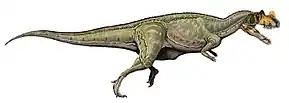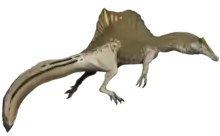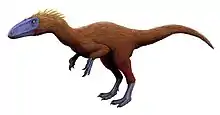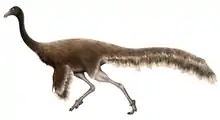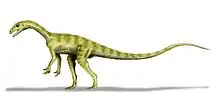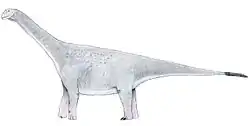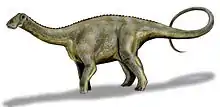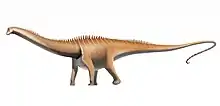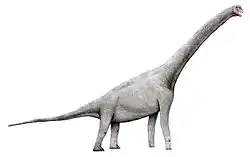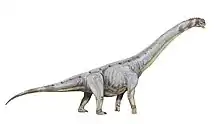Eoraptor
Eoraptor (/ˈiːoʊˌræptər/) is a genus of small, lightly-built, basal saurischian dinosaur. One of the earliest-known dinosaurs, it lived approximately 231 to 228 million years ago,[1] during the Late Triassic in Western Gondwana, in the region that is now northwestern Argentina. The type and only species, Eoraptor lunensis, was first described in 1993, and is known from several well-preserved skeletons. Eoraptor had heterodont dentition, which suggests that it was omnivorous.
| Eoraptor | |
|---|---|
 | |
| Reconstructed skeleton, Royal Ontario Museum | |
| Scientific classification | |
| Kingdom: | Animalia |
| Phylum: | Chordata |
| Clade: | Dinosauria |
| Clade: | Saurischia |
| Suborder: | †Sauropodomorpha (?) |
| Genus: | †Eoraptor Sereno et al. 1993 |
| Species: | †E. lunensis |
| Binomial name | |
| †Eoraptor lunensis Sereno et al. 1993 | |
History of discovery
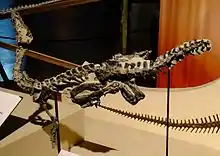
The bones of this primitive dinosaur were first discovered in 1991, by University of San Juan paleontologist Ricardo Martínez, during field work conducted by the University of Chicago and the University of San Juan. The holotype specimen PVSJ 512 was discovered in muddy siltstone belonging to the Cancha de Bochas Member of the Ischigualasto Formation in Argentina. The fossils in this formation were deposited in the Carnian stage of the Triassic period, approximately 235 to 228 million years ago. It took almost 12 months to collect the holotype, which was then shipped to the Field Museum of Natural History in Chicago for preparation by William F. Simpson and Bob Masek. The fossil was first put on display in Chicago and was then returned to San Juan, Argentina, where it went on display at the Museum of Natural Sciences.
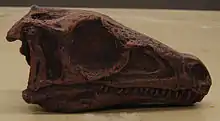
The genus name Eoraptor is derived from the Greek word eos (ηως) meaning "dawn",[2] a reference to its primitive nature and the Latin word raptor meaning "plunderer", a reference to its presumed carnivorous nature and its grasping hand. The specific name lunensis is derived from the Latin words luna meaning "moon", and the suffix ~ensis, meaning "inhabitant". The specific name lunensis is a reference to its place of discovery: the "Valle de la Luna", which is Spanish for "Valley of the Moon." This valley is so named because of its arid, otherworldly appearance, evocative of a lunar landscape. The type species is Eoraptor lunensis, which means "dawn plunderer from the Valley of the Moon". Eoraptor was described and named by Paul Sereno, Catherine Forster, Raymond R. Rogers, and Alfredo M. Monetta in 1993.[3]
Description
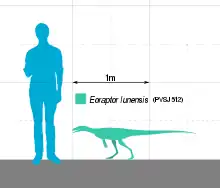

Eoraptor had a slender body that grew to about 1 metre (3 ft 3 in) in length, with an estimated weight of about 10 kilograms (22 lb). It had a lightly built skull with a slightly enlarged external naris.[4] Like the coelophysoids which would appear millions of years later, Eoraptor had a kink in its upper jaws, between the maxilla and the premaxilla. Paul Sereno et al. (2013) observed that the lower jaw had a mid-mandibular joint.[4] It ran digitigrade, and upright on its hind legs. The femur of the holotype specimen PVSJ 512 is 152 millimetres (6.0 in), and the tibia is 157 millimetres (6.2 in), suggesting that it was a fast runner. Its forelimbs are only half the length of its hindlimbs, suggesting that it was bipedal. All of its long bones have hollow shafts.[4] Eoraptor had five digits on each 'hand', the three longest of which ended in large claws and were presumably used to handle prey. Scientists have surmised that the fourth and fifth digits were too tiny to be of any use in hunting. The ilium is supported by three sacral vertebrae, unlike that of the coeval Herrerasaurus which is supported by only two sacrals, a basal trait.[5] Eoraptor had vertebral centra that are hollow, a feature present in some of its ancestors.
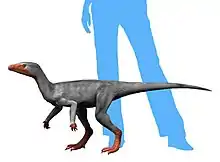
Bonaparte (1996) interpreted the relatively large orbital opening in the skull as a juvenile trait. Ronald Tykoski agreed (2005) and suggested that certain skull features of the type specimen suggested that it was young, specifically, the skull bones are not completely fused, relatively large orbits, and a short snout.[6] Paul Sereno et al. (1993), supported the notion that Eoraptor was an adult specimen based on the closure of sutures in the vertebral column, and the partial fusion of the scapulocoracoid.[3]
According to Sereno et al. (1993), Eoraptor can be distinguished based on the fact that its premaxillary and anterior maxillary teeth are leaf-shaped, the external nares are slightly enlarged, and the premaxilla is observed to have a slender posterolateral process.[3] Max Langer and Michael Benton (2006) noted that Eoraptor can be distinguished based on the fact that the proximal part of its fibula is extremely transversely compressed.[7]
Classification
In 1993 Paul Sereno and his colleagues described and named Eoraptor, and determined it to be one of the earliest dinosaurs.[3][8] Its age was determined by several factors, not least because it lacked the specialized features of any of the major groups of later dinosaurs, including its lack of specialized predatory features. In 1995, Sereno posited that Eoraptor is the earliest-recorded theropod, and is closest to "the hypothetical dinosaurian condition than any other dinosaurian subgroup."[9] The precise placement of Eoraptor within Dinosauria has been unstable, with opinion often varying between a basal saurischian and a basal theropod.[10] When it was first described by Sereno and Forster in 1993, it was regarded as a theropod, based on its "functionally tridactyl hand" and other anatomical features.[3] In 2011, a study conducted by Hans-Dieter Sues, Sterling J. Nesbitt, David S. Berman and Amy C. Henrici featuring a description of Daemonosaurus, also concluded that there is now enough fossil evidence to confidently classify Eoraptor as a theropod.[11] The study noted that the "transitional suite of character states" of the recently discovered dinosaurs, Daemonosaurus and Tawa further support that Eoraptor is a basal theropod, and not a basal saurischian or a basal sauropodomorph.[12] The following phylogenetic tree illustrates the relationships of Eoraptor among the major theropod groups based on various studies conducted in the 2010s.[13] On the other hand, several studies from 2012 onward have recovered Eoraptor as an early sauropodomorph, rather than a theropod.[4][14][15][16][17][18][19][20]

| Theropoda |
| ||||||||||||||||||||||||||||||||||||||||||||||||
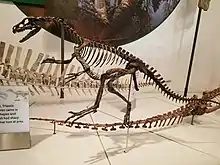
Philip Currie (1997) found Eoraptor anatomically closer to what would be considered the ancestral morphotype of both saurischian and ornithischian dinosaurs.[21] In 2011, Martinez et al. (the team that described Eodromaeus) found Eoraptor to be a basal sauropodomorph, with characteristic features from the group.[22][23] Michael Benton expressed his hesitation to this, and claimed that it is "quite a shift" to remove Eoraptor from Theropoda and then place it in Sauropodomorpha.[23] A subsequent study by Apaldetti, Martinez, Alcober, and Pol published in 2011 found Eoraptor to be a saurischian close to sauropodomorphs and theropods, though was unable to resolve which of the two branches, if either, it fell within.[24] Sereno et al. (2013) redescribed the holotype skeleton and concluded that Eoraptor was not a theropod but a basal sauropodomorph, consistent with the earlier observation made by Martinez et al. (2011).[4]
A large phylogenetic analysis of early dinosaurs by Matthew Baron, David Norman and Paul Barrett (2017) found Eoraptor to be the earliest diverging member of Theropoda, within the larger clade Ornithoscelida.[25] A phylogenetic analysis published with the description of new Buriolestes remains in 2018, based on Langer et al. (2017)[26] placed Eoraptor in a clade of early sauropodomorphs, alongside Buriolestes, Panphagia, Pampadromaeus, and Saturnalia.[27]
Paleobiology
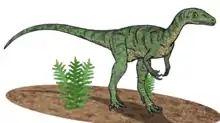
Eoraptor is thought to have been an omnivore,[4] although its dentition is quite similar to that of Buriolestes, which is considered faunivorous.[14][15] It was a swift sprinter and, upon catching its prey, it would use claws and teeth to tear the prey apart. Unlike later, carnivorous dinosaurs, it lacked a sliding joint at the articulation of the lower jaw, with which to hold large prey. Furthermore, only some of its teeth were curved and saw-edged, unlike those in the mouths of later theropods. The heterodont dentition of Eoraptor consists of both serrated, recurved teeth in the upper jaw, like the teeth of theropods, and leaf-shaped teeth in the lower jaw, like the teeth of basal sauropodomorphs.[3] Eoraptor had 4 teeth in the premaxilla and 18 teeth in the maxilla, a dental formula not dissimilar to that of Herrerasaurus.
Paleoecology
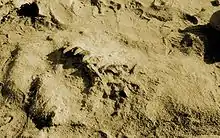
During the Late Triassic Period, the Ischigualasto Formation was a volcanically active floodplain covered by forests, with a warm and humid climate,[28] but subject to seasonal variations including strong rainfall.[29] Vegetation consisted of ferns, horsetails, and giant conifers, which formed highland forests along the banks of rivers.[30] Herrerasaurus remains appear to have been the most common among the carnivores of the Ischigualasto Formation.[31] Sereno (1993) noted that Eoraptor was found in "close association" with therapsids, rauisuchians, archosaurs, Saurosuchus and the dinosaurs Herrerasaurus and Pisanosaurus, all of whom lived in its paleoenvironment. Herbivores were represented by rhynchosaurs such as Hyperodapedon; aetosaurs; cynodonts like Probelesodon, kannemeyeriid dicynodonts such as Ischigualastia; and traversodontids such as Exaeretodon. These non-dinosaurian herbivores were much more abundant than early dinosaurs.[32] Dinosaur fossils, including those of Eoraptor only represent approximately 6% of the total sample that has been recovered from the Ischigualasto Formation (Rogers et al., 1993), which suggests that dinosaurs were less numerous than other tetrapods.[33]
References
- Alcober, Oscar A.; Martinez, Ricardo N. (2010). "A new herrerasaurid (Dinosauria, Saurischia) from the Upper Triassic Ischigualasto Formation of northwestern Argentina". ZooKeys (63): 55–81. doi:10.3897/zookeys.63.550. PMC 3088398. PMID 21594020.
- Liddell, Henry George and Robert Scott (1980). A Greek-English Lexicon (Abridged ed.). United Kingdom: Oxford University Press. ISBN 0-19-910207-4.
- Sereno, P.C.; Forster, C.A.; Rogers, R.R.; Moneta, A.M. (1993). "Primitive dinosaur skeleton from Argentina and the early evolution of the Dinosauria". Nature. 361 (6407): 64–66. Bibcode:1993Natur.361...64S. doi:10.1038/361064a0. S2CID 4270484.
- Sereno, Paul C.; Martínez, Ricardo N.; Alcober, Oscar A. (2013). "Osteology of Eoraptor lunensis (Dinosauria, Sauropodomorpha). Basal sauropodomorphs and the vertebrate fossil record of the Ischigualasto Formation (Late Triassic: Carnian-Norian) of Argentina". Journal of Vertebrate Paleontology Memoir. 12: 83–179. doi:10.1080/02724634.2013.820113. S2CID 86006363.
- Langer, Max C. (2004). "Basal Saurischia". In Weishampel, David B.; Dodson, Peter; and Osmólska, Halszka (eds.). The Dinosauria (2nd ed.). Berkeley: University of California Press. pp. 25–46. ISBN 0-520-24209-2.
- Tykoski, 2005. Anatomy, ontogeny and phylogeny of coelophysoid theropods. PhD Dissertation. University of Texas at Austin. 553 pp.
- Langer, M. C., and Benton, M. J., 2006, Early Dinosaurs: a phylogenetic study: Journal of Systematic Palaeontology, vol 4, n. 4, p. 309-358.
- Paul G.S., The Princeton Field Guide to Dinosaurs (Princeton University Press, 2010), p. 68.
- P. C. Sereno. 1995. Theropoda: early evolution and major patterns of diversification Journal of Vertebrate Paleontology 15(3, suppl.):52A-53A
- Nesbitt, S. J.; Smith, N. D.; Irmis, R. B.; Turner, A. H.; Downs, A.; Norell, M. A. (2009). "A complete skeleton of a Late Triassic saurischian and the early evolution of dinosaurs". Science. 326 (5959): 1530–1533. Bibcode:2009Sci...326.1530N. doi:10.1126/science.1180350. PMID 20007898.
- Bergman D.S., Sues H-D. (2011), "A late-surviving basal theropod dinosaur from the latest Triassic of North America", Proceedings of the Royal Society B, published online 13-4-2011.
- Hans-Dieter Sues, Sterling J. Nesbitt, David S. Berman and Amy C. Henrici (2011). "A late-surviving basal theropod dinosaur from the latest Triassic of North America" Proceedings of the Royal Society B 278 (1723): 3459–3464
- Hendrickx, C.; Hartman, S.A.; Mateus, O. (2015). "An Overview of Non- Avian Theropod Discoveries and Classification". PalArch's Journal of Vertebrate Palaeontology. 12 (1): 1–73.
- Cabreira, Sergio Furtado; Kellner, Alexander Wilhelm Armin; Dias-da-Silva, Sérgio; Roberto da Silva, Lúcio; Bronzati, Mario; Marsola, Júlio Cesar de Almeida; Müller, Rodrigo Temp; Bittencourt, Jonathas de Souza; Batista, Brunna Jul’Armando; Raugust, Tiago; Carrilho, Rodrigo (November 2016). "A Unique Late Triassic Dinosauromorph Assemblage Reveals Dinosaur Ancestral Anatomy and Diet". Current Biology. 26 (22): 3090–3095. doi:10.1016/j.cub.2016.09.040. PMID 27839975.
- Müller, Rodrigo T; Langer, Max C; Bronzati, Mario; Pacheco, Cristian P; Cabreira, Sérgio F; Dias-Da-Silva, Sérgio (2018-05-15). "Early evolution of sauropodomorphs: anatomy and phylogenetic relationships of a remarkably well-preserved dinosaur from the Upper Triassic of southern Brazil". Zoological Journal of the Linnean Society. doi:10.1093/zoolinnean/zly009. ISSN 0024-4082.
- MartÍnez, Ricardo N.; Apaldetti, Cecilia; Abelin, Diego (November 2012). "Basal sauropodomorphs from the Ischigualasto Formation" (PDF). Journal of Vertebrate Paleontology. 32 (sup1): 51–69. doi:10.1080/02724634.2013.819361. ISSN 0272-4634.
- Pacheco, Cristian; Müller, Rodrigo T.; Langer, Max; Pretto, Flávio A.; Kerber, Leonardo; Dias da Silva, Sérgio (2019-11-08). "Gnathovorax cabreirai : a new early dinosaur and the origin and initial radiation of predatory dinosaurs". PeerJ. 7: e7963. doi:10.7717/peerj.7963. ISSN 2167-8359. PMC 6844243. PMID 31720108.
- Müller, Rodrigo Temp (2019-11-12). "Craniomandibular osteology of Macrocollum itaquii (Dinosauria: Sauropodomorpha) from the Late Triassic of southern Brazil". Journal of Systematic Palaeontology. 18 (10): 805–841. doi:10.1080/14772019.2019.1683902. ISSN 1477-2019.
- Garcia, Maurício S.; Pretto, Flávio A.; Dias-Da-Silva, Sérgio; Müller, Rodrigo T. (2019). "A dinosaur ilium from the Late Triassic of Brazil with comments on key-character supporting Saturnaliinae". Anais da Academia Brasileira de Ciências. 91 (suppl 2): e20180614. doi:10.1590/0001-3765201920180614. ISSN 1678-2690. PMID 31411248.
- Müller, Rodrigo Temp; Langer, Max Cardoso; Dias-da-Silva, Sérgio (2018-11-30). "An exceptionally preserved association of complete dinosaur skeletons reveals the oldest long-necked sauropodomorphs". Biology Letters. 14 (11): 20180633. doi:10.1098/rsbl.2018.0633. ISSN 1744-9561. PMC 6283919. PMID 30463923.
- Currie, P.J. (1997). Theropoda. In Encyclopedia of Dinosaurs (P.J. Currie, and K. Padian, Eds.) pp 731-736. Academic Press, San Diego, California.
- Martinez, Ricardo N.; Sereno, Paul C.; Alcober, Oscar A.; Colombi, Carina E.; Renne, Paul R.; Montañez, Isabel P.; Currie, Brian S. (2011). "A basal dinosaur from the dawn of the dinosaur era in southwestern Pangaea". Science. 331 (6014): 206–10. Bibcode:2011Sci...331..206M. doi:10.1126/science.1198467. PMID 21233386.
- Kaplan M, "Move over Eoraptor", http://www.nature.com/news, 13-1-2011.
- Apaldetti, C; Martinez, RN; Alcober, OA; Pol, D (2011). "A New Basal Sauropodomorph (Dinosauria: Saurischia) from Quebrada del Barro Formation (Marayes-El Carrizal Basin), Northwestern Argentina". PLOS ONE. 6 (11): e26964. doi:10.1371/journal.pone.0107672. PMC 4178034. PMID 25259845.
- Baron, M.G.; Norman, D.B.; Barrett, P.M. (2017). "A new hypothesis of dinosaur relationships and early dinosaur evolution". Nature. 543 (7646): 501–506. Bibcode:2017Natur.543..501B. doi:10.1038/nature21700. PMID 28332513. S2CID 205254710.
- Max C. Langer; Martín D. Ezcurra; Oliver W. M. Rauhut; Michael J. Benton; Fabien Knoll; Blair W. McPhee; Fernando E. Novas; Diego Pol; Stephen L. Brusatte (2017). "Untangling the dinosaur family tree". Nature. 551 (7678): E1–E3. Bibcode:2017Natur.551E...1L. doi:10.1038/nature24011. hdl:1983/d088dae2-c7fa-4d41-9fa2-aeebbfcd2fa3. PMID 29094688.
- Müller, Rodrigo T.; Langer, Max C.; Bronzati, Mario; Pacheco, Cristian P.; Cabreira, Sérgio F.; Dias-Da-Silva, Sérgio (15 May 2018). "Early evolution of sauropodomorphs: anatomy and phylogenetic relationships of a remarkably well-preserved dinosaur from the Upper Triassic of southern Brazil". Zoological Journal of the Linnean Society. 184 (4): 1187–1248. doi:10.1093/zoolinnean/zly009. S2CID 90215853.
- Tucker, Maurice E.; Benton, Michael J. (1982). "Triassic environments, climates, and reptile evolution" (PDF). Palaeogeography, Palaeoclimatology, Palaeoecology. 40 (4): 361–379. Bibcode:1982PPP....40..361T. doi:10.1016/0031-0182(82)90034-7. Archived from the original (PDF) on 2009-01-26. Retrieved 2009-07-23.
- Columbi, Carina E. (2008-10-05). Stable isotope analysis of fossil plants from the Upper Triassic Ischigualasto Formation in the northwest of Argentina. Houston, TX: The Geological Society of America. Archived from the original on 2012-01-11. Retrieved 2009-07-23.
- Sereno, P.C.; Novas, F.E. (1992). "The complete skull and skeleton of an early dinosaur". Science. 258 (5085): 1137–1140. Bibcode:1992Sci...258.1137S. doi:10.1126/science.258.5085.1137. PMID 17789086.
- Rogers, R. R.; Swisher, III; Sereno, P.C.; Monetta, A.M.; Forster, C.A.; Martinez, R.N. (1993). "The Ischigualasto tetrapod assemblage (Late Triassic, Argentina) and 40Ar/39Ar dating of dinosaur origins". Science. 260 (5109): 794–797. Bibcode:1993Sci...260..794R. doi:10.1126/science.260.5109.794. PMID 17746113.
- Bonaparte, J.F. (1970). "Annotated list of the South American Triassic tetrapods". Gondwana Symposium Proceedings and Papers. 2: 665–682.
- Rogers, R. R.; Swisher, C. C. III; Sereno, P. C.; Monetta, A. M.; Forster, C. A.; Martinez, R. N. (1993). "The Ischigualasto Tetrapod Assemblage (Late Triassic, Argentina) and 40Ar/39Ar Dating of Dinosaur Origins". Science. 260 (5109): 794–797. Bibcode:1993Sci...260..794R. doi:10.1126/science.260.5109.794. PMID 17746113.
External links
 Media related to Eoraptor at Wikimedia Commons
Media related to Eoraptor at Wikimedia Commons Data related to Eoraptor at Wikispecies
Data related to Eoraptor at Wikispecies- Paul Sereno's paleontology website
- Paleobiology Database entry
- Eoraptor lunensis at DigiMorph
